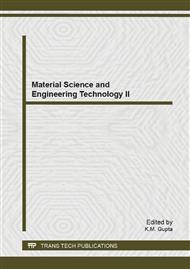p.53
p.60
p.64
p.69
p.74
p.79
p.87
p.92
p.98
Experimental and Numerical Study of Plain-Woven Aramid Fabric
Abstract:
In this paper, the tensile properties of plain-woven aramid fabric style 724 (Kevlar® 129 fibre, 1000 denier, 24×24 yarns per inch) and the tensile properties of individual aramid yarn extracted from the fabric are presented. It was found that this fabric is balanced with less than 5% difference in strength between the warp and weft directions. The mechanical properties of the individual yarns were found to be lower than those reported for Kevlar® 129 fibre, which is explained by the fact that the yarns were damaged during the extraction process or weaving process. A 3D finite-element model of the tensile testing of plain-woven fabric was built at the mesoscale in Abaqus/Explicit by modelling individual crimped yarns and taking into account friction. Material properties and yarn geometry for the model were obtained from experimental observations. An orthotropic elastic model with failure criterion based on the yield stress was used. Numerical results were analysed and compared with experimental results. It was found that the numerical model can reproduce the physical experimental observations, the yield strength and the failure strain.
Info:
Periodical:
Pages:
74-78
Citation:
Online since:
December 2013
Authors:
Price:
Сopyright:
© 2014 Trans Tech Publications Ltd. All Rights Reserved
Share:
Citation:


